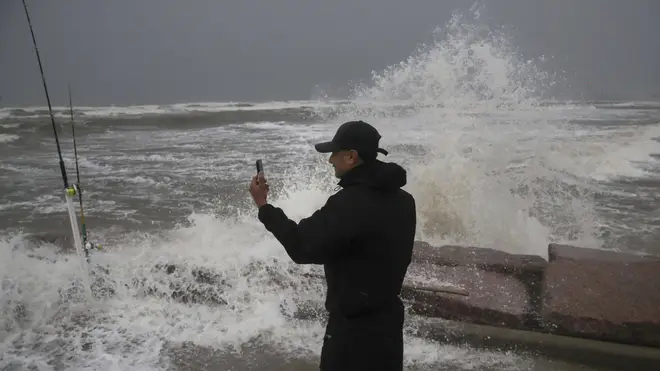
Ian Payne 4am - 7am
14 September 2021, 14:54

The storm has brought more than 12in of rain along the same area badly hit by Hurricane Harvey in 2017.
Tropical Storm Nicholas has struck the Texas coast as a hurricane, drenching Louisiana, knocking out power to hundreds of thousands of people and bringing the potential for life-threatening flash floods across the US Deep South.
The storm dumped more than a foot (12in) of rain along the same area swamped by Hurricane Harvey in 2017.
Nicholas made landfall on the eastern part of the Matagorda Peninsula and was soon downgraded to a tropical storm.
1230 AM CDT 14 September — Hurricane #Nicholas has made landfall on the eastern part of the Matagorda Peninsula, about 10 miles west-southwest of Sargent Beach, Texas. Maximum sustained winds were 75 MPH with higher gusts at landfall.
Latest: https://t.co/t0VkuDIHwk pic.twitter.com/Ymbk7CyUVE
— National Hurricane Center (@NHC_Atlantic) September 14, 2021
It was about 15 miles south-southwest of Houston, Texas, with maximum winds of 60mph as of 7am CDT (1pm BST) on Tuesday, according to the US National Hurricane Centre in Miami.
Nicholas is the 14th named storm of the 2021 Atlantic hurricane season.
Galveston saw nearly 14in of rain from Nicholas while Houston reported more than 6in of rain – a fraction of what fell during Harvey, which dumped more than 60in of rain in south-east Texas over a four-day period.
The storm is moving north-northeast at 8mph with the centre of Nicholas expected to move slowly over south-eastern Texas on Tuesday and over south-western Louisiana on Wednesday.

Nicholas, which is expected to weaken into a tropical depression by Wednesday, could dump up to 20in of rain in parts of central and southern Louisiana.
Much of Texas’ coastline was under a tropical storm warning that included potential flash floods and urban flooding. Texas governor Greg Abbott said authorities have placed rescue teams and resources in the Houston area and along the coast.
In Houston, officials fear that heavy rain could inundate streets and flood homes. Authorities deployed high-water rescue vehicles throughout the city and erected barricades at more than 40 locations that tend to flood, Mayor Sylvester Turner said.
“This city is very resilient. We know what we need to do. We know about preparing,” said Mr Turner, referring to four major flood events that have hit the Houston area in recent years, including devastating damage from Harvey.

Meteorologist Kent Prochazka of the US National Weather Service said Nicholas’ winds downed trees in coastal counties and caused some petrol stations to lose awnings.
“Right before it made landfall, it abruptly intensified into a hurricane and as it moved inland, the pressures began to rise with it. The winds have relaxed slightly and now we’re getting down into tropical storm force (winds),” he said.
CenterPoint Energy reported that over 400,000 customers lost power as the storm rolled through Houston.
Numerous school districts along the Texas Gulf Coast cancelled classes on Monday because of the incoming storm.
The Houston school district, the state’s largest, as well as others, announced that classes would be cancelled on Tuesday.
10 PM CDT 13 September Key Messages for recently upgraded Hurricane #Nicholas . The Texas coast from Port O'Connor north to Freeport has been upgraded to a Hurricane Warning.
Latest Advisory: https://t.co/t0VkuDr67K pic.twitter.com/E7Iuguk1qL
— National Hurricane Center (@NHC_Atlantic) September 14, 2021
The weather threat also closed multiple Covid-19 testing and vaccination sites in the Houston and Corpus Christi areas and forced the cancellation of a Harry Styles concert scheduled for Monday evening in Houston.
A tornado or two may be possible on Tuesday along the upper Texas and south-west Louisiana coast, according to the weather service.
Nicholas brought rain to the same area of Texas that was hit hard by Harvey, which was blamed for at least 68 deaths, including 36 in the Houston area.
NHC is monitoring two systems in the Atlantic with the potential for tropical cyclone development over the next several days https://t.co/tW4KeFW0gB pic.twitter.com/Tux148tKJB
— National Hurricane Center (@NHC_Atlantic) September 14, 2021
After Harvey, voters approved the issuance of 2.5 billion dollars (£1.8 billion) in bonds to fund flood-control projects, including the widening of bayous. The 181 projects designed to mitigate damage from future storms are at different stages of completion.
University of Miami hurricane researcher Brian McNoldy said he expected that Nicholas “will be magnitudes less than Harvey in every regard”.
The worry with Nicholas will be how slowly it moves. Storms are moving slower in recent decades, and Nicholas could get stuck between two other weather systems, according to hurricane researcher Jim Kossin of The Climate Service.
Louisiana governor John Bel Edwards declared a state of emergency on Sunday night, ahead of the storm’s arrival in a state still recovering from Hurricane Ida and last year’s Hurricane Laura and historic flooding.